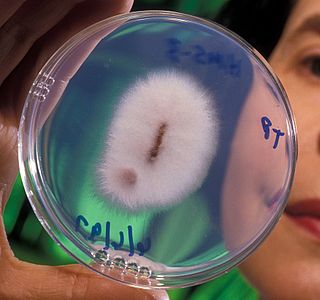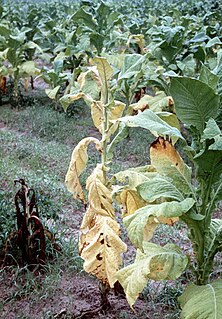
Fusarium oxysporumpronounce (help·info), an ascomycete fungus, comprises all the species, varieties and forms recognized by Wollenweber and Reinking within an infrageneric grouping called section Elegans. It is part of the family Nectriaceae.

Fusarium wilt is a common vascular wilt fungal disease, exhibiting symptoms similar to Verticillium wilt. This disease has been investigated extensively since the early years of this century. The pathogen that causes Fusarium wilt is Fusarium oxysporum. The species is further divided into formae speciales based on host plant.
Panama disease is a plant disease that infects banana plants. It is a wilting disease caused by the fungus Fusarium oxysporum f. sp. cubense (Foc). The pathogen is resistant to fungicides and its control is limited to phytosanitary measures.

Fusarium/fjuˈzɛəriəm/ (help·info) is a large genus of filamentous fungi, part of a group often referred to as hyphomycetes, widely distributed in soil and associated with plants. Most species are harmless saprobes, and are relatively abundant members of the soil microbial community. Some species produce mycotoxins in cereal crops that can affect human and animal health if they enter the food chain. The main toxins produced by these Fusarium species are fumonisins and trichothecenes. Despite most species apparently being harmless, some Fusarium species and subspecific groups are among the most important fungal pathogens of plants and animals.

Nufar basil is the first variety of sweet basil that is resistant to fusarium wilt. Fusarium wilt is a disease that causes sudden wilting and death in multiple species, including basil. It is caused by the fungus Fusarium oxysporum f. sp. basilicum, which attacks the xylem in the stem, blocking water uptake and leading to a characteristic sudden leaf wilt that does not respond to watering. Nufar basil is resistant to fusarium wilt, remaining asymptomatic even when infected. It was released in 1999 in Israel by the breeders of the Agricultural Research Organization, and commercialized by Genesis Seeds.

Fusarium oxysporum f.sp. albedinis is a fungal plant pathogen that causes a disease known as Bayoud disease or fusarium wilt primarily on date palm.
Fusarium oxysporum f.sp. asparagi is a fungal plant pathogen infecting asparagus.
Fusarium oxysporum f.sp. betae is a destructive fungal plant pathogen. It causes Fusarium yellows or fusarium wilt, characterized by yellowing and dwarfing.

Fusarium oxysporum f.sp. ciceris is a fungal plant pathogen that causes fusarium wilt of chickpea.
Fusarium oxysporum f.sp. cyclaminis is a fungal plant pathogen infecting cyclamens.
Fusarium oxysporum f.sp. dianthi is a fungal plant pathogen infecting carnations.
Fusarium oxysporum f.sp. radicis-lycopersici is a fungal plant pathogen.

Fusarium subglutinans is a fungal plant pathogen.

Fusarium oxysporum f.sp. lycopersici is a fungal plant pathogen. It is a big pathogen to the tomato plant. It has a violet to white color on most media but does not produce a pigment on King's B medium.

Fusarium oxysporum f. sp. cubensePronunciation (help·info) is a fungal plant pathogen that causes Panama disease of banana, also known as fusarium wilt of banana.
Throughout human history, fungi have been utilized as a source of food and harnessed to ferment and preserve foods and beverages. In the 20th century, humans have learned to harness fungi to protect human health, while industry has utilized fungi for large scale production of enzymes, acids, and biosurfactants. With the advent of modern nanotechnology in the 1980s, fungi have remained important by providing a greener alternative to chemically synthesized nanoparticle.
Bayoud disease is an epiphytic fungal disease of date palm. The pathogen responsible for the disease is Fusarium oxysporum f.sp. albedinis.
Streptomyces rochei is a bacterium species from the genus of Streptomyces which has been isolated from soil in Russia. Streptomyces rochei produces borrelidin, butyrolactol A, butyrolactol B, uricase and streptothricin. Streptomyces rochei has antifungal activity against Fusarium oxysporum f.sp. lycopersici and Aspergillus fumigatus.
Vascular wilt in the perennial shrub lulo or naranjilla is a disease caused by the fungus Fusarium oxysporum f. sp. quitoense.
Cytochrome P450, family 55, also known as CYP55, is a cytochrome P450 family in fungi supposed to derived from horizontal gene transfer of Actinomycetes CYP105 family member in the ancestor of all Dikarya. The first gene identified in this family is the CYP55A1 from Fusarium oxysporum encoding the NADPH dependent reductase of nitrous oxide.






